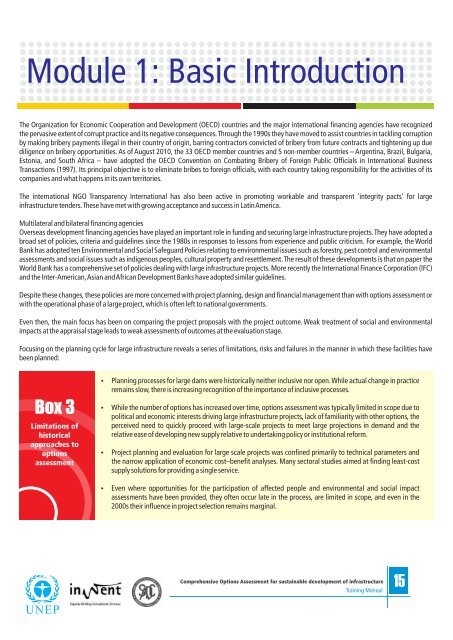Comprehensive Option Assesment - UNEP
Comprehensive Option Assesment - UNEP
Comprehensive Option Assesment - UNEP
Create successful ePaper yourself
Turn your PDF publications into a flip-book with our unique Google optimized e-Paper software.
Module 1: Basic Introduction<br />
The Organization for Economic Cooperation and Development (OECD) countries and the major international financing agencies have recognized<br />
the pervasive extent of corrupt practice and its negative consequences. Through the 1990s they have moved to assist countries in tackling corruption<br />
by making bribery payments illegal in their country of origin, barring contractors convicted of bribery from future contracts and tightening up due<br />
diligence on bribery opportunities. As of August 2010, the 33 OECD member countries and 5 non-member countries – Argentina, Brazil, Bulgaria,<br />
Estonia, and South Africa – have adopted the OECD Convention on Combating Bribery of Foreign Public Officials in International Business<br />
Transactions (1997). Its principal objective is to eliminate bribes to foreign officials, with each country taking responsibility for the activities of its<br />
companies and what happens in its own territories.<br />
The international NGO Transparency International has also been active in promoting workable and transparent 'integrity pacts' for large<br />
infrastructure tenders. These have met with growing acceptance and success in Latin America.<br />
Multilateral and bilateral financing agencies<br />
Overseas development financing agencies have played an important role in funding and securing large infrastructure projects. They have adopted a<br />
broad set of policies, criteria and guidelines since the 1980s in responses to lessons from experience and public criticism. For example, the World<br />
Bank has adopted ten Environmental and Social Safeguard Policies relating to environmental issues such as forestry, pest control and environmental<br />
assessments and social issues such as indigenous peoples, cultural property and resettlement. The result of these developments is that on paper the<br />
World Bank has a comprehensive set of policies dealing with large infrastructure projects. More recently the International Finance Corporation (IFC)<br />
and the Inter-American, Asian and African Development Banks have adopted similar guidelines.<br />
Despite these changes, these policies are more concerned with project planning, design and financial management than with options assessment or<br />
with the operational phase of a large project, which is often left to national governments.<br />
Even then, the main focus has been on comparing the project proposals with the project outcome. Weak treatment of social and environmental<br />
impacts at the appraisal stage leads to weak assessments of outcomes at the evaluation stage.<br />
Focusing on the planning cycle for large infrastructure reveals a series of limitations, risks and failures in the manner in which these facilities have<br />
been planned:<br />
Box 3<br />
Limitations of<br />
historical<br />
approaches to<br />
options<br />
assessment<br />
Planning processes for large dams were historically neither inclusive nor open. While actual change in practice<br />
remains slow, there is increasing recognition of the importance of inclusive processes.<br />
While the number of options has increased over time, options assessment was typically limited in scope due to<br />
political and economic interests driving large infrastructure projects, lack of familiarity with other options, the<br />
perceived need to quickly proceed with large-scale projects to meet large projections in demand and the<br />
relative ease of developing new supply relative to undertaking policy or institutional reform.<br />
Project planning and evaluation for large scale projects was confined primarily to technical parameters and<br />
the narrow application of economic cost–benefit analyses. Many sectoral studies aimed at finding least-cost<br />
supply solutions for providing a single service.<br />
Even where opportunities for the participation of affected people and environmental and social impact<br />
assessments have been provided, they often occur late in the process, are limited in scope, and even in the<br />
2000s their influence in project selection remains marginal.<br />
<strong>Comprehensive</strong> <strong>Option</strong>s Assessment for sustainable development of infrastructure<br />
Training Manual<br />
15
















